Spinal disease and Paralysis in Dogs
SPINAL DISEASE AND PARALYSIS IN DOGS
INTERVERTEBRAL DISC DISEASE – slipped disc
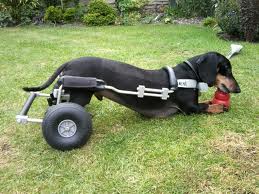
Slipped discs are very common in certain breeds of dogs, especially those with long backs. The breeds most often affected are the Dachshund, the Pekingese, certain terrier breeds and the Pug. Dachshunds and Pekingeses are chondrodystrophic breeds with a long spinal column and short, crooked legs and joints. Discs between their vertebrae will degenerate early.
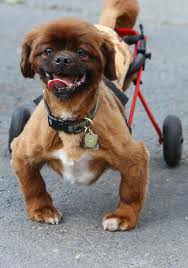
Healthy discs act like flexible cushions between vertebrae. (5) As they age, discs lose pliability and harden. (4)This happens unusually early in certain breeds like the Dachshund and the Pekingese, often between three and six years of age. When discs are damaged, this is called Inter vertebral Disc Disease (IVDD). In IVDD, the disc herniates through its outer shell, like the inside of a grape popping out its skin. This causes a sudden pressure against the spinal cord. (3)(4) The risk is worsened by obesity, jumping, rough handling, or intense exercise. (1)
PREVENTION OF DISC DISEASE
You must keep your dog’s weight normal.
Keep him from jumping on or off furniture, and climbing stairs. (3)
Exercise his muscles and legs daily, but (5) don’t allow things that stress the back, such as sitting up and begging.
Use a ramp to allow access to furniture.
When holding him, keep the back horizontal by holding them like a football, with the hind quarters under your arm, and your hands under the chest.(2)
Symptoms of IVDD:
Difficulty standing or with stairs
Hunched walking
Yelping or biting when lifted, due to neck and back pain
Hind leg weakness or in coordination
Total hindquarters paralysis
Inability to defecate, or urinate.(3)(4)
These symptoms can be seen with other spinal diseases, so an examination by a vet is needed.(4)
DIAGNOSIS OF IVDD AND SLIPPED DISCS
NEUROLOGICAL EXAM FOR DOGS WITH SLIPPED DISCS AND SPINAL PROBLEMS
A good neurological exam allows your vet to get an idea of where in the back or brain the problem is and then focus x rays and diagnostic tests on those particular areas. These tests should be performed by a vet only to prevent further spinal injury.
PINCH TEST and PRICK TEST
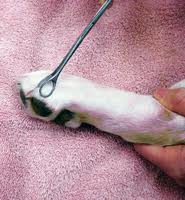
The skin is pricked with a needle to see if the dog can feel light pain. The toes are then pinched softly then very hard to see if the dog can feel it. If the leg withdraws this only indicates an intact reflex, not a sensation, but if he yelps or nips, it shows he retains deep pain. (4) The loss of deep pain signals the need for immediate surgery.
PLACING THE PAWS IN UNUSUAL POSITIONS
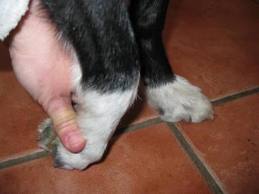
The paw is placed on its top surface to see if the dog recognizes and can feel the paw is in the wrong position and then if it can right the foot.
PLACING TEST
The pet is held up and then its paws are placed below a surface so that the top of the paws touch the underside of a table, for example. The normal response is for the dog to pick up the foot and put it on top of the table. If there is spinal cord damage the dog may not do this.
PROPRIOCEPTION
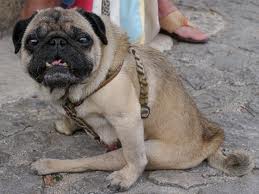
This allows the vet to see if your dog knows where the legs are in relation to his body and the ground. Dogs with slipped discs frequently stumble and may drag the legs slightly, or may even not use the legs at all in severe cases. Your vet will observe the dogs walking and then see if he or she can cope with turning round, changing direction and stopping and starting. This gives an indication of the severity of the spinal injury.
WHEELBARROWING, HOPPING AND WALKING ON TWO LEGS :
Your vet will see if your dog can support weight on two legs – the front two, the back two and also the legs on either side of the body.
PANNICULUS REFLEX
This test gives an idea of where the slipped disc is localised but it isn’t a hard and fast rule. The skin is pricked and normally, the skin will react by shivering slightly. Often, at the level of the lesion, the skin will not feel the prick and thus not react.
REFLEXES
The patella reflex is performed on both back legs to see if the dog reacts and how much or how little he or she reacts to tapping. This gives an idea of whether there is nerve damage on the pathway of the reflex. A similar test can be performed in the front legs but it is not as reliable.
CRANIAL NERVES
These are nerves that originate in the brain and go to and from the important places in the head, including the nose, eyes, ears face, mouth, tongue, throat and then also go down the neck into the body to regulate the heart, blood pressure and gut function for example. Because we know where these nerves come out in the brain, it allows a vet to pinpoint if there is disease in the brain that could be affecting balance and proprioception and thus affecting fore and hind leg function.
X-RAYS
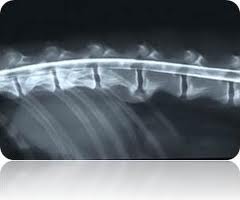
X-rays definitely aid diagnosis. Your vet will preferably sedate your pet and take a minimum of 2 views, one from the side of the pet and one either lying on his back or his stomach. The spinal column is checked for narrowing of disc spaces, spondylosis (a bridge of bone between two vertebrae indicating instability ), any sign of disease in the bones, and that the vertebral canal is smooth and even and also check for any arthritic changes. Specialists may also do an x ray with dye known as a Myelogram or a MRI scan to locate the damaged disc. Myelograms do carry a risk of seizures and both the myelogram and MRI scan should be done under general anaesthetic or very deep sedation.
TREATMENT OF IVDD/SPINAL PROBLEMS AND DISC DISEASE
IVDD is an emergency. If your dog looks like he can’t walk, don’t leave it, even for a few hours. The longer pressure lasts on the spinal cord and the more severe it is, the greater the chance of permanent problems. Chances of improvement drop within hours, so don’t wait!! (3)
In mild cases, steroids, muscle relaxants and anti-inflammatories are used to reduce pain and swelling. (1)(5) If your dog has an episode of acute onset sever back pain, but he or she is still able to use the legs and bear weight on them, then it is recommended in many cases that they are kept in hospital for a few days. They basically stay in a cage and don’t move around a lot. Often these injured dogs get insecure at home and try to follow the owners around, doing their backs more harm than good. If they don’t rest, it is possible they could get worse and definitely need expensive spinal surgery.
In severe cases, or in cases that rapidly deteriorate, surgery is indicated. Removing damaged disc material is delicate, specialist surgery and can make a huge difference. Dogs may need a cart to get around if paralysed (1) A new minimally invasive procedure called “Percutaneous laser disk ablation” has been developed at the Oklahoma State University Veterinary Hospital.(1)
Up to 78% of dachshunds recover in time from IVDD without surgery. They should be confined for at least six weeks. Water therapy, acupuncture and chiropractic treatments help. Treating IVDD is expensive, so get pet insurance!! (5) Dachshunds that don’t recover can do well on wheels to support their hindquarters, but it depends on the individual temperament of the dog as to how they will cope. They also can’t be left in their harness all the time, so it can be labour intensive to look after them. Many do very well, however.
http://www.dodgerslist.com – support group for dachshund owners who own dogs with IVDD.
BUTTERFLY VERTEBRAE AND DEFORMED VERTEBRAE
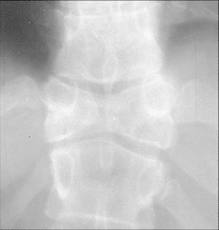
Pugs are prone to genetic malformations of the vertebrae themselves – they may be fused to form a butterfly shape, known as a butterfly vertebra, which can put pressure on the spinal cord. These dogs show symptoms of back pain and paralysis which can come and go but is sometimes irreversible. It is important that their backs are x rayed to make a proper diagnosis and possibly an MRI scan performed to assess how much of the spinal cord is being compressed under the malformed vertebrae. Mild cases may respond to steroids (cortisone.)
FIBROCARTILAGENOUS EMBOLI
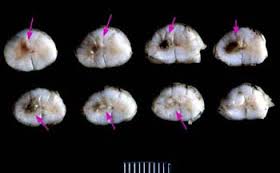
This is a disease that is hard to understand as it can lead to a sudden and severe paralysis in dogs. It is almost like a ‘stroke’ in the spinal cord. In this disease, a small piece of cartilage or disc material forms a embolus or clot in one of the small arteries that supplies an area of spinal cord. It can happen anywhere in the spinal cord and have no pre exiting symptoms and a perfectly healthy dog can suddenly be a totally paralysed one.
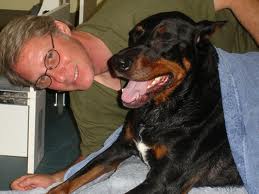
Sometimes with fibrocartilagenous emboli, the paralysis can affect one side of the body more than the other, depending on where it is located. X rays and initial diagnostic tests usually appear completely normal. The only way to diagnose it properly is with an MRI scan. Mildly and moderately affected dogs can recover over time with cage rest and physiotherapy. They can benefit from ant inflammatory drugs as well in some cases, at the discretion of your vet.
SPINAL TUMOURS AND CANCER OF THE SPINE AND BACK
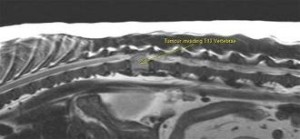
Tumours or cancer of the spine can occur either within the spinal cord, around the spinal cord (inside the vertebral canal ) or in the bones of the vertebrae. Symptoms vary, in many cases there is a gradual loss of the use of the legs, either back legs, front legs or both, sometimes there is pain, and in some cases (for example a cancer of the bone causing weakening of the bone in the vertebrae and a sudden collapse of the bone onto the cord ) sudden or acute paralysis. The prognosis is usually guarded to poor as surgery is difficult to impossible.

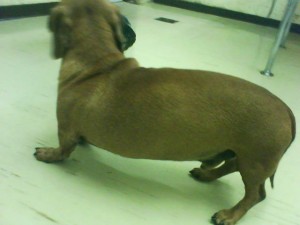
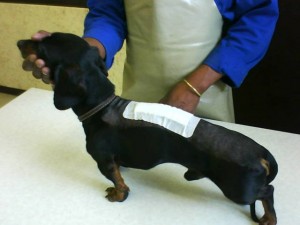
Leave a Reply
You must be logged in to post a comment.